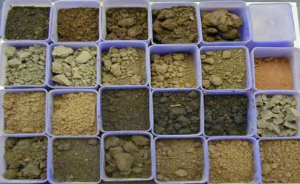Types of soils
The soil is classified as under
Non – cohesive soils :
They are made of the coarser particle. In the dry state, it possesses no plasticity and lacks any cohesion.
- Grival:
These are weathered and disintegrated rocks fragment from residual deposited, according to grain sizes, coarse particles of rocks having sizes 4.75 mm to 80 mm are known as Gravels include river deposits made of rounded pebbles and shingles. Cemented and compact gravels do not shrink or swell heavy load without any appreciable settlement. Hence, they provide very good foundation next to the rock.
- Sandy Soil:
These are non-cohesive deposit from disintegration. Coarsest particles of silica obtained from the disintegration of rocks, having size 0.06 to 4.75 mm are sands. Sands are mostly river deposited. Sands provide good foundation except when they are loose and not confined.
- Silt:
The fines particles of rocks having size 0.002 mm to 0.06 mm are classified as silt. It is a fine-grained to evaporation or absorption of water. It does not sustain heavy load and shows signs of settlement. Hence it is not suitable for foundations.
Cohesive soils:
cohesive soils possess cohesion and plasticity.
- Shale:
It is compressed form of laminated clay.
- Clays:
Fine soil particles having a size less than 0.002 mm to 0.06 mm are classified as clay. it is soft, plastic, and can be mounded in a moist condition. When dry it shrinks and when dry it shrinks and when wet it swells. It shows large settlement and takes a long time for it. it is therefore difficult to predict the total settlement and time taken for it. Hence, it is not suitable for the foundation.
- Blacks cotton soils:
It shows large shrinkage and settlement hence it forms the very poor base for foundation.
- Peat:
It is the soil containing organic matter. It is also not suitable for the foundation.
- Made up Grounds:
the grounds are formed after filing with refuse etc. it is therefore very unsuitable for the foundation.
Unstratified rocks cannot be spat into thin sheets.
They don’t have layered structure and cleavage plane e.g Trap, marble etc.


